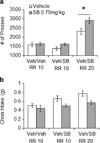The effects of pharmacological modulation of the serotonin 2C receptor on goal-directed behavior in mice
- PMID: 26558617
- PMCID: PMC4878435
- DOI: 10.1007/s00213-015-4135-3
The effects of pharmacological modulation of the serotonin 2C receptor on goal-directed behavior in mice
Abstract
Rationale: Impaired goal-directed motivation represents a debilitating class of symptoms common to psychological disorders including schizophrenia and some affective disorders. Despite the known negative impact of impaired motivation, there are currently no effective pharmacological interventions to treat these symptoms.
Objectives: Here, we evaluate the effectiveness of the serotonin 2C (5-HT2C) receptor selective ligand, SB242084, as a potential pharmacological intervention for enhancing goal-directed motivation in mice. The studies were designed to identify not only efficacy but also the specific motivational processes that were affected by the drug treatment.
Methods: We tested subjects following treatment with SB242084 (0.75 mg/kg) in several operant lever pressing assays including the following: a progressive ratio (PR) schedule of reinforcement, an effort-based choice task, a progressive hold down task (PHD), and various food intake tests.
Results: Acute SB242084 treatment leads to an increase in instrumental behavior. Using a battery of behavioral tasks, we demonstrate that the major effect of SB242084 is an increase in the amount of responses and duration of effort that subjects will make for food rewards. This enhancement of behavior is not the result of non-specific hyperactivity or arousal nor is it due to changes in food consumption.
Conclusions: Because of this specificity of action, we suggest that the 5-HT2C receptor warrants further attention as a novel therapeutic target for treating pathological impairments in goal-directed motivation.
Keywords: Feeding; Locomotor activity; Motivation; Operant; SB242084; Serotonin receptor.
Figures





References
Publication types
MeSH terms
Substances
Grants and funding
LinkOut - more resources
Full Text Sources
Other Literature Sources
Research Materials

